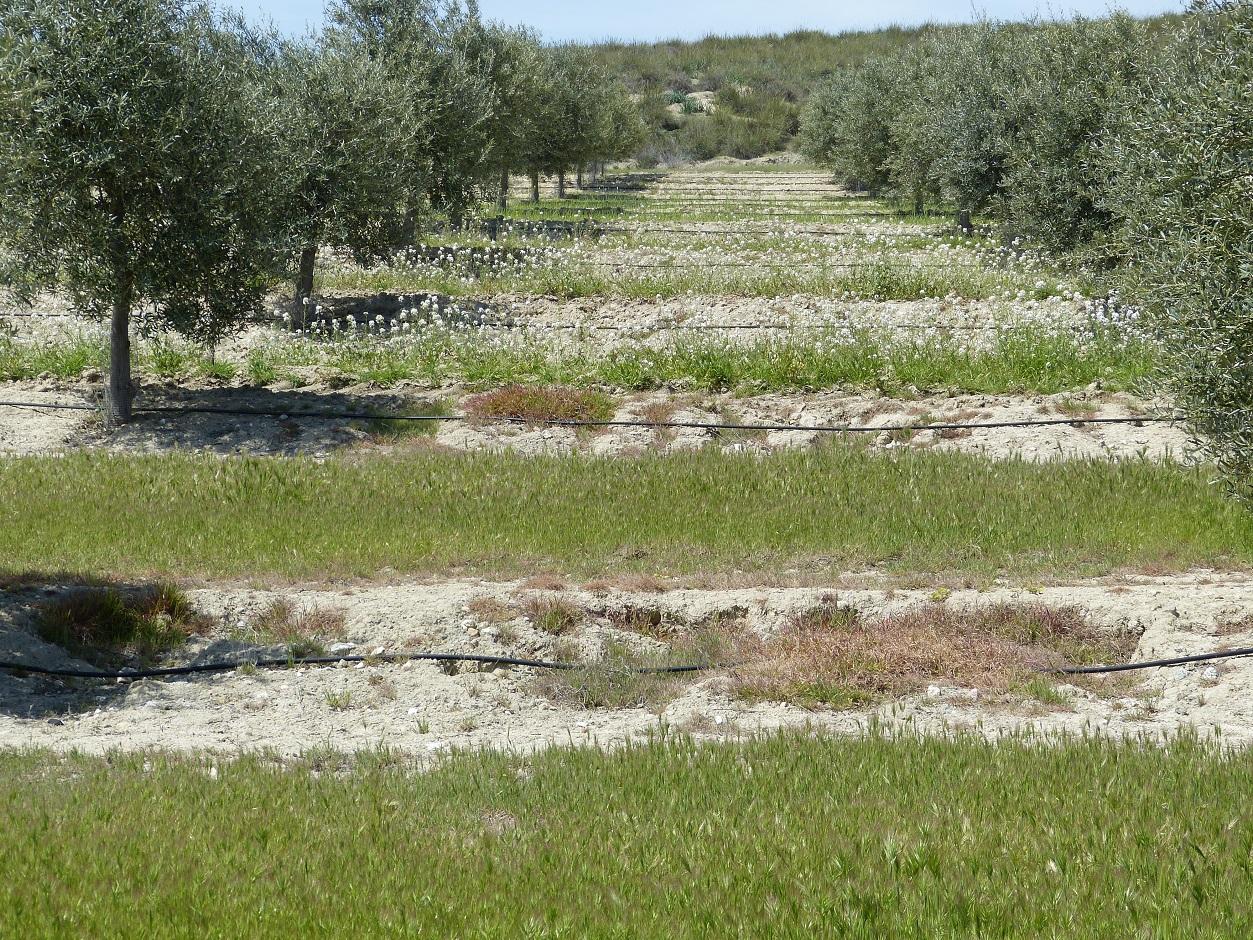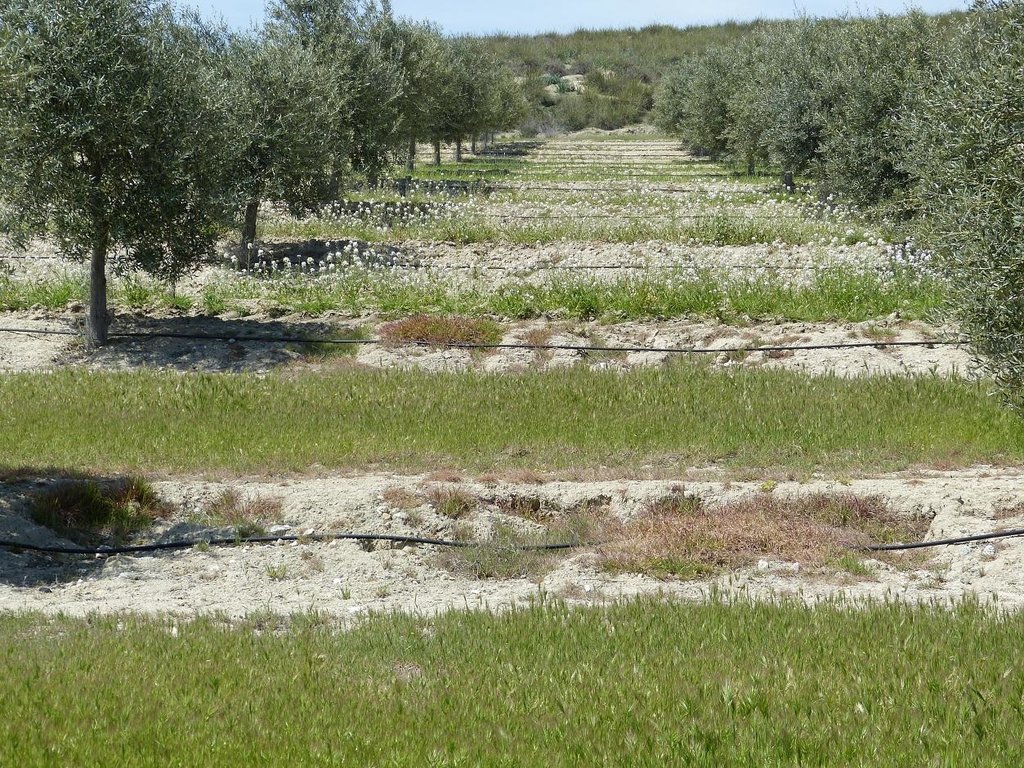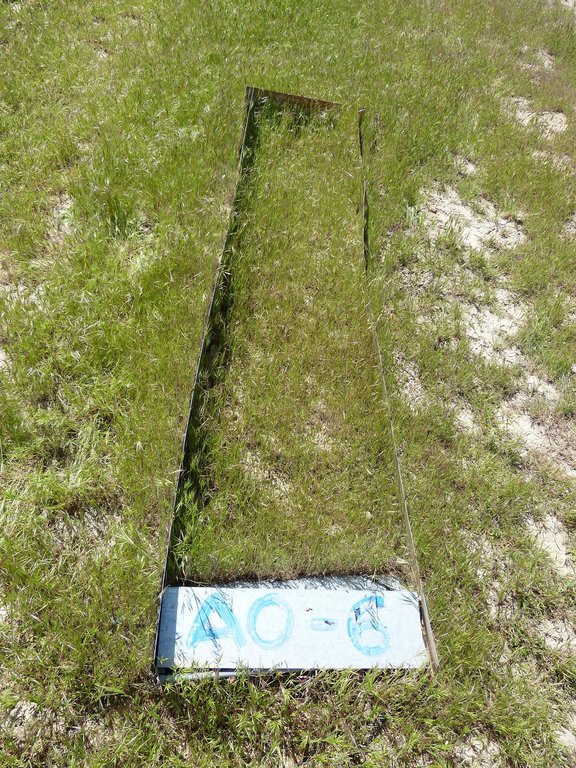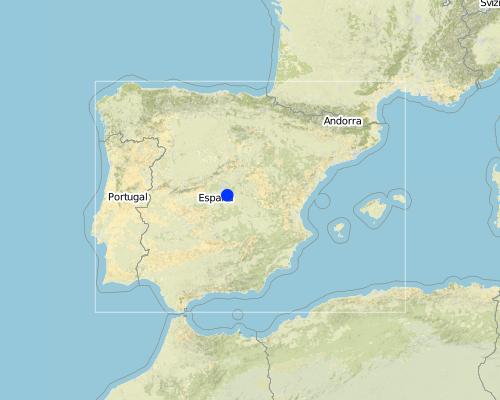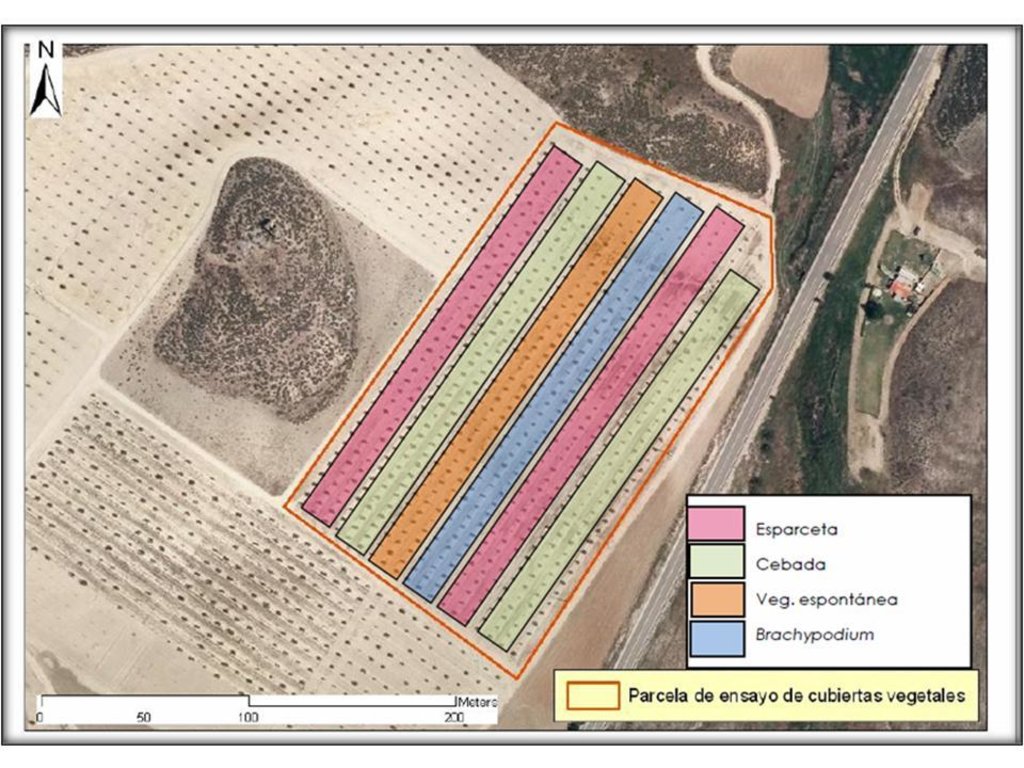Cover crops on olive orchards [Spain]
- Creation:
- Update:
- Compiler: Blanca Sastre
- Editor: –
- Reviewer: Deborah Niggli
Cubiertas vegetales en olivar para reducir la erosión
technologies_1173 - Spain
View sections
Expand all Collapse all1. General information
1.2 Contact details of resource persons and institutions involved in the assessment and documentation of the Technology
land user:
Bienes Ramón
IMIDRA
Finca "El Encín", Autovía A2, km 38,2 (28800, Alcalá de Henares)
Spain
1.3 Conditions regarding the use of data documented through WOCAT
When were the data compiled (in the field)?
01/04/2013
The compiler and key resource person(s) accept the conditions regarding the use of data documented through WOCAT:
Yes
1.4 Declaration on sustainability of the described Technology
Is the Technology described here problematic with regard to land degradation, so that it cannot be declared a sustainable land management technology?
No
2. Description of the SLM Technology
2.1 Short description of the Technology
Definition of the Technology:
The technology involves soil management with cover crops (natural or spontaneous) in the streets of an olive grove to evaluate their effectiveness against soil loss by water erosion and its effect on production and quality of virgin olive oil.
2.2 Detailed description of the Technology
Description:
Three types of covers have been used within the olive streets, applying herbicide on the trees.
A cover of grasses, barley (Hordeum vulgare), another cover legume sainfoin (Onobrychis viciifolia) both planted annually in November, and a cover of Brachypodium distachyon just planted the first year, and managed to harvest to allow reseeding. Finally, we have applied a deeper tillage in November as control treatment.
The purpose of cover crops in the olive streets is to reduce or even stop soil loss caused by erosion occurring on the bare ground. Furthermore, the effect of each of the covers on the olive harvest and on the quantity and quality of virgin olive oil is evaluated.
The establishment consists of planting seeds of barley and sainfoin annually, Brachypodium the first year, and plowing the streets of the control treatment. The operation is the same for all treatments, consisting of one or two mowings in spring to avoid competition for water with the crop covers.
Herbicides are applied on olive trees in order to facilitate management under the tree such as collection tasks, application of treatments and pruning.
The plot is located in a research centre, so that its object is only applied research of this technique.
The soil is a Xeric-Haplogypsid, with a dominance of marl-gypsum. The topography is dominated by small hills and former terraces of the Tajo river.
The climate is Mediterranean-continental, with an average temperature of 13,8ºC and 395 mm of rainfall, which falls mainly in Autumn and Spring.
2.3 Photos of the Technology
2.5 Country/ region/ locations where the Technology has been applied and which are covered by this assessment
Country:
Spain
Region/ State/ Province:
Madrid
Further specification of location:
Colmenar de Oreja
Map
×2.6 Date of implementation
If precise year is not known, indicate approximate date:
- 10-50 years ago
2.7 Introduction of the Technology
Specify how the Technology was introduced:
- during experiments/ research
Comments (type of project, etc.):
In the central part of Spain it is a technique that is used scarcely by farmers, though in Andalusia it has been researching on it for decades and there are large areas in which it is used.
3. Classification of the SLM Technology
3.1 Main purpose(s) of the Technology
- reduce, prevent, restore land degradation
3.2 Current land use type(s) where the Technology is applied

Cropland
- Tree and shrub cropping
Comments:
Major land use problems (compiler’s opinion): Conventional management involves tilling between 3 and 5 times a year to eliminate the natural vegetation, which increases the loss of soil and reduced soil moisture. It can also reduce the quality of olive oil.
Major land use problems (land users’ perception): Vegetation between the olive is perceived as a negative management for being a competitor for water and nutrients with the crop. For this, the olive growers style difficults collection tasks in the Fall and Winter and favors the appearance of gullies. Correction of these gullies incurs a heavier workload and higher economic costs.
3.3 Further information about land use
Water supply for the land on which the Technology is applied:
- mixed rainfed-irrigated
Number of growing seasons per year:
- 1
Specify:
Longest growing period in days: 90, Longest growing period from month to month: February-May; Second longest growing period in days: 60, Second longest growing period from month to month: October-December
3.4 SLM group to which the Technology belongs
- improved ground/ vegetation cover
3.5 Spread of the Technology
Comments:
Total area covered by the SLM Technology is 0.3 m2.
Working plot is situated in the experimental farm "La Chimenea", which is owned by Comunidad de Madrid.
3.6 SLM measures comprising the Technology

agronomic measures
- A1: Vegetation/ soil cover
Comments:
Type of agronomic measures: cover cropping
3.7 Main types of land degradation addressed by the Technology

soil erosion by water
- Wt: loss of topsoil/ surface erosion
- Wg: gully erosion/ gullying

chemical soil deterioration
- Cn: fertility decline and reduced organic matter content (not caused by erosion)

physical soil deterioration
- Pc: compaction
- Pk: slaking and crusting

biological degradation
- Bc: reduction of vegetation cover
- Bh: loss of habitats
- Bq: quantity/ biomass decline
- Bs: quality and species composition/ diversity decline
- Bl: loss of soil life

water degradation
- Ha: aridification
- Hs: change in quantity of surface water
- Hp: decline of surface water quality
Comments:
Main causes of degradation: soil management (An intense plowing)
3.8 Prevention, reduction, or restoration of land degradation
Specify the goal of the Technology with regard to land degradation:
- prevent land degradation
- reduce land degradation
Comments:
4. Technical specifications, implementation activities, inputs, and costs
4.1 Technical drawing of the Technology
4.2 Technical specifications/ explanations of technical drawing
The olive orchard is of the variety "cornicabra" with a frame planting of 7 m x 6 m. On the streets different species have been planted (barley, sainfoin, Brachypodium distachyon) to study its effect respect to conventional tillage. On each side of the line of olive trees, a strip of 0.5m has been left without vegetation (treated with herbicide).
All cover crops are cut in spring, before they start to compete for water and nutrients with the crop (one or two passes, depending on the year). Mowed residues are left in the area to also protect the soil, encouraging nutrient recycling.
A selection of species or spontaneous vegetation have to be done, depending on the study area. In our case the best option seems to be sowing Brachypodium distachyon.
Location: Colmenar de Oreja. Comunidad de Madrid
Date: 15/10/2010
Technical knowledge required for field staff / advisors: moderate (The technique is simple, but requires a detailed management to avoid competition with the crop covers for nutrients and water.)
Technical knowledge required for land users: moderate (The technique is simple, but requires a detailed management to avoid competition with the crop covers for nutrients and water.)
Main technical functions: control of raindrop splash, control of dispersed runoff: retain / trap, improvement of ground cover, increase of surface roughness, improvement of surface structure (crusting, sealing), increase in organic matter, increase in nutrient availability (supply, recycling,…)
Secondary technical functions: control of dispersed runoff: impede / retard, improvement of topsoil structure (compaction), improvement of subsoil structure (hardpan), stabilisation of soil (eg by tree roots against land slides), increase of infiltration, increase / maintain water stored in soil
Cover cropping
Material/ species: Barley
Quantity/ density: 280 kg
Remarks: 153 kg/Ha
Agronomic measure: Cover cropping
Material/ species: Sainfoin (Onobrychis viciifolia)
Quantity/ density: 37,5 kg
Remarks: 42 kg/Ha
Agronomic measure: Cover cropping
Material/ species: Brachypodium distachyon
Quantity/ density: 19 kg
Remarks: 40 kg/Ha
4.3 General information regarding the calculation of inputs and costs
other/ national currency (specify):
Euro
Indicate exchange rate from USD to local currency (if relevant): 1 USD =:
0.75
Indicate average wage cost of hired labour per day:
48.00
4.5 Costs and inputs needed for establishment
| Specify input | Unit | Quantity | Costs per Unit | Total costs per input | % of costs borne by land users | |
|---|---|---|---|---|---|---|
| Labour | labour | ha | 1.0 | 27.0 | 27.0 | |
| Plant material | seeds | ha | 1.0 | 130.0 | 130.0 | |
| Plant material | sainfoin seeds | ha | 1.0 | 100.0 | 100.0 | |
| Plant material | Brachypodium seeds | ha | 1.0 | 20.0 | 20.0 | |
| Total costs for establishment of the Technology | 277.0 | |||||
Comments:
Duration of establishment phase: 2 month(s)
4.6 Maintenance/ recurrent activities
| Activity | Type of measure | Timing/ frequency | |
|---|---|---|---|
| 1. | Sowing | Agronomic | yearly |
| 2. | Mowing | Agronomic | yearly (or twice a year) |
4.7 Costs and inputs needed for maintenance/ recurrent activities (per year)
| Specify input | Unit | Quantity | Costs per Unit | Total costs per input | % of costs borne by land users | |
|---|---|---|---|---|---|---|
| Labour | labour | ha | 1.0 | 18.0 | 18.0 | |
| Total costs for maintenance of the Technology | 18.0 | |||||
Comments:
Machinery/ tools: Sowing machine and weeding machine
The indicated cost has been calculated for an olive orchad under semiarid condition (300 mm annual rainfall) in the centre of Spain, with a marl-gypsum soil. The average slope is less than 10%.
4.8 Most important factors affecting the costs
Describe the most determinate factors affecting the costs:
Seed quality, seed predation, drought, etc.
5. Natural and human environment
5.1 Climate
Annual rainfall
- < 250 mm
- 251-500 mm
- 501-750 mm
- 751-1,000 mm
- 1,001-1,500 mm
- 1,501-2,000 mm
- 2,001-3,000 mm
- 3,001-4,000 mm
- > 4,000 mm
Specifications/ comments on rainfall:
The average rainfall is around 300-350 mm, mainly in Autumn and Spring with erosive events in late Summer.
Agro-climatic zone
- semi-arid
Thermal climate class: temperate. There is a dry period from late May to late September.
5.2 Topography
Slopes on average:
- flat (0-2%)
- gentle (3-5%)
- moderate (6-10%)
- rolling (11-15%)
- hilly (16-30%)
- steep (31-60%)
- very steep (>60%)
Landforms:
- plateau/plains
- ridges
- mountain slopes
- hill slopes
- footslopes
- valley floors
Altitudinal zone:
- 0-100 m a.s.l.
- 101-500 m a.s.l.
- 501-1,000 m a.s.l.
- 1,001-1,500 m a.s.l.
- 1,501-2,000 m a.s.l.
- 2,001-2,500 m a.s.l.
- 2,501-3,000 m a.s.l.
- 3,001-4,000 m a.s.l.
- > 4,000 m a.s.l.
5.3 Soils
Soil depth on average:
- very shallow (0-20 cm)
- shallow (21-50 cm)
- moderately deep (51-80 cm)
- deep (81-120 cm)
- very deep (> 120 cm)
Soil texture (topsoil):
- medium (loamy, silty)
Topsoil organic matter:
- medium (1-3%)
- low (<1%)
5.4 Water availability and quality
Ground water table:
on surface
Availability of surface water:
poor/ none
Water quality (untreated):
for agricultural use only (irrigation)
5.5 Biodiversity
Species diversity:
- medium
5.6 Characteristics of land users applying the Technology
Market orientation of production system:
- mixed (subsistence/ commercial
Individuals or groups:
- employee (company, government)
Level of mechanization:
- manual work
- mechanized/ motorized
Indicate other relevant characteristics of the land users:
Population density: 50-100 persons/km2
5.7 Average area of land owned or leased by land users applying the Technology
- < 0.5 ha
- 0.5-1 ha
- 1-2 ha
- 2-5 ha
- 5-15 ha
- 15-50 ha
- 50-100 ha
- 100-500 ha
- 500-1,000 ha
- 1,000-10,000 ha
- > 10,000 ha
5.8 Land ownership, land use rights, and water use rights
Land ownership:
- state
- Regional Government
- Regional Government
Comments:
As far as it is a research project, there is no population applying it yet.
6. Impacts and concluding statements
6.1 On-site impacts the Technology has shown
Socio-economic impacts
Production
crop production
Comments/ specify:
Neither fruit nor olive oil production differed by the different cover crops or tillage
Water availability and quality
demand for irrigation water
Quantity before SLM:
0,06 m3 water/m3 soil
Quantity after SLM:
0,12 m3 water/m3 soil
Comments/ specify:
Average value measured with probes in dry season.
Income and costs
expenses on agricultural inputs
Quantity before SLM:
16 l
Quantity after SLM:
2 l
Comments/ specify:
The use of herbicide is limited to the line of trees.
workload
Quantity before SLM:
3-4 labours per year
Quantity after SLM:
1
Comments/ specify:
Tillage is not necessary, but there are other differents labours with less work.
Socio-cultural impacts
health situation
Comments/ specify:
By reducing labours, the emission of CO2 into the atmosphere are reduced, and somehow mitigates global climate change. By reducing herbicide use reduces its danger and effects on health and the ecosystem.
cultural opportunities
Comments/ specify:
Aesthetically is more valued an olive grove with vegetation cover, while increasing biodiversity.
SLM/ land degradation knowledge
Comments/ specify:
The effects of vegetation cover can be observed in a few years, and the example could easily spread among farmers in the area.
conflict mitigation
Contribution to human well-being
Comments/ specify:
By reducing the number of labours of machinery (tillage, herbicide application) less CO2 is emitted into the atmosphere, reducing the impact on Global Climate Change. By reducing the use of herbicides, reduces its introduction in the system. The auxiliary fauna that is favored by the use of cover crops, may result in declining the plagues, affecting less use of herbicides.
Ecological impacts
Water cycle/ runoff
water quantity
Comments/ specify:
The amount of water that infiltrates is higher, reducing which reaches the surface runways.
water quality
Comments/ specify:
Surface water drags less soil particles cover crops treatments, reducing water turbidity.
surface runoff
Comments/ specify:
The amount of water which infiltrates cover crops is much greater than in the tilled soils, reducing the surface runoff.
evaporation
Comments/ specify:
In the dry season, when the vegetation parched, its effect is protective of evaporation of soil water.
Soil
soil moisture
Quantity before SLM:
0.06 m3/m3
Quantity after SLM:
0.12 m3/m3
soil cover
soil loss
Quantity before SLM:
1 kg/m2 ye
Quantity after SLM:
0.17 kg/m2
Comments/ specify:
Brachypodium is the cover that achieves maximal reduction of soil loss by erosion.
soil crusting/ sealing
Quantity before SLM:
80 %
Quantity after SLM:
0
Comments/ specify:
If it has been covered all the soil with vegetation, physical soil crust is not formed.
soil compaction
Comments/ specify:
Si se ha cubierto todo el suelo, la costra física no aparece respecto del tratamiento de herbicida donde ocupaba gran parte de su superficie.
nutrient cycling/ recharge
soil organic matter/ below ground C
Quantity before SLM:
0.07 % SOC
Quantity after SLM:
0.14 % SOC
Biodiversity: vegetation, animals
biomass/ above ground C
Quantity before SLM:
0
Quantity after SLM:
5 t/ha yea
plant diversity
Comments/ specify:
En función del tipo de cubierta, si es una cubierta sembrada esta diversidad es poca.
animal diversity
beneficial species
Comments/ specify:
With more vegetation there are an increase of beneficial species.
habitat diversity
pest/ disease control
Comments/ specify:
Because of the action of auxiliar fauna.
Climate and disaster risk reduction
fire risk
Quantity before SLM:
0
Quantity after SLM:
40 %
Comments/ specify:
Una cubierta mal manejada puede incrementar el riesgo de incendio.
6.2 Off-site impacts the Technology has shown
downstream flooding
Comments/ specify:
Ya que la zona es pequeña, la reducción de las inundaciones también, pero a medida que se vaya extendiendo
damage on neighbours' fields
Comments/ specify:
El arrastre de sedimentos a otras parcelas e infraestructuras se reduce drásticamente con el empleo de una cubierta vegetal.
6.3 Exposure and sensitivity of the Technology to gradual climate change and climate-related extremes/ disasters (as perceived by land users)
Gradual climate change
Gradual climate change
| Season | Type of climatic change/ extreme | How does the Technology cope with it? | |
|---|---|---|---|
| annual temperature | increase | well |
Climate-related extremes (disasters)
Meteorological disasters
| How does the Technology cope with it? | |
|---|---|
| local rainstorm | well |
| local windstorm | not known |
Climatological disasters
| How does the Technology cope with it? | |
|---|---|
| drought | not well |
Hydrological disasters
| How does the Technology cope with it? | |
|---|---|
| general (river) flood | well |
Other climate-related consequences
Other climate-related consequences
| How does the Technology cope with it? | |
|---|---|
| reduced growing period | well |
Comments:
The selection of species can be adapted to a dryer climate. The species which performed the best is Brachypodium distachyon. Once established, this species covers the soil and is more or less independent of precipitation.
6.4 Cost-benefit analysis
How do the benefits compare with the establishment costs (from land users’ perspective)?
Short-term returns:
slightly negative
Long-term returns:
very positive
How do the benefits compare with the maintenance/ recurrent costs (from land users' perspective)?
Short-term returns:
neutral/ balanced
Long-term returns:
positive
Comments:
The management of cover crops is a reduction of the labours, although these have to be more accurate than conventional (adapted to each time). By having cover crops, the farmer may gather olives at the time that suits him, to obtain maximum profitability, and not when the weather permits (heavy rains and / or continuous, make the machinery can not enter any time ).
6.5 Adoption of the Technology
Comments:
La tecnología has sido sólo implementada de forma experimental en una finca por investigadores, por lo que no hay experiencia con agricultores.
6.7 Strengths/ advantages/ opportunities of the Technology
| Strengths/ advantages/ opportunities in the compiler’s or other key resource person’s view |
|---|
| It is a simple technique that greatly improves soil quality, while reducing erosion losses. |
| This technique is cheap and easy to implement. |
| Soil moisture increases, favoring the production of olive fruit, in areas where water is limited. |
| This technique facilitates olive harvest at the right time as determined by the farmer, as vegetation cover prevents soil mudding and facilitates access of machinery even when wet. |
| Decreases the use of fertilization, as cover crops increase the amount of C and N in the soil. |
6.8 Weaknesses/ disadvantages/ risks of the Technology and ways of overcoming them
| Weaknesses/ disadvantages/ risks in the land user’s view | How can they be overcome? |
|---|---|
| The management change from what they have been done all their lives to a new land management culture. | Demonstrating that this technique improves soil and crop quality. |
| Weaknesses/ disadvantages/ risks in the compiler’s or other key resource person’s view | How can they be overcome? |
|---|---|
| Changing plot management and the need to be aware of the evolution of the cover, to determine the right time to mow. | With guidance in the early stages of implementation. |
| Mistrust of olive growers regarding the effect that the cover has in the production of olive fruit or in the olive grove. | Showing plots with and without covers at the moment that olive trees have the fruit, and give production data, both in olive fruit as in olive oil. |
| The need for using new machinery or different from the usual, as sowing or weeding machine. | Provide financing for the acquisition of new machinery. If it would not be possible, in the early stages of implementation, facilitate the machinery to avoid investment by the farmer. |
7. References and links
7.1 Methods/ sources of information
- field visits, field surveys
- interviews with land users
7.2 References to available publications
Title, author, year, ISBN:
Evaluation of infiltration measurements under olive trees in Córdoba. Soil and Tillage Research 48(4):303-315. Vanderlinden, K., Gabriels, D., Giráldez, J. V. 1998.
Title, author, year, ISBN:
El manejo de la cubierta vegetal en el control de la erosión en olivar. Perspectivas de la Degradación del Suelo. eds. R. Bienes y M.J. Marques. I Simposio Nacional sobre Control de la Erosión y Degradación del Suelo. Madrid. pp. 43-54.Saavedra, M.2003
Title, author, year, ISBN:
Implantation and management of vegetation covers: a control system against erosion in olive grove and ligenouw crops. Agricultura 788: 218-222.Saavedra, M., Castro, J., Humanes, M.D. 1998.
Title, author, year, ISBN:
Cubiertas vegetales en el olivar. Agricultura.Rodríguez Lizana, A. 2003
Title, author, year, ISBN:
Influencia de las cubiertas vegetales vivas sobre el contenido de agua en el suelo. Cubiertas vegetales en olivar, eds. A. Rodríguez Lizana, R. Ordoñez Fernandez y J. Gil Ribes, Junta de Andalucía. Consejería de Agricultura y Pesca, pp. 41-53.Pastor, M. 2007
Title, author, year, ISBN:
Sistemas de manejos de suelo. In: Barranco D. Fernandez RE. Rallo L (eds.). El cultivo del olivo. Madrid (Spain). Mundiprensa p 190-228.Pastor, M., Castro, J., Vega, V. Humanes, M.D. 1997
Title, author, year, ISBN:
Introducción a la agricultura de conservación en olivar. Evaluación del comportamiento de los sistemas de manejo de suelos. Cubiertas vegetales en olivar. eds. A. Rodríguez Lizana. R. Ordoñez Fernandez y J. Gil Ribes. Junta de Andalucía. Consejería de Agricultura y Pesca. pp. 7-16.Martínez Raya, A., Francia, J.R., Martínez Vilela, A. 2007
Title, author, year, ISBN:
Soil erosion and runoff response to plant-cover strips on semiarid slopes (SE Spain). Land Degradation & Development 17(1):1-11.Martínez Raya, A., Durán Zuazo,V. H., Francia Martínez, J. R. 2005.
Title, author, year, ISBN:
Grass strip effects on runoff and soil loss. Agronomie 24: 129-136.Le Bissonais, Y., Lecomte, V., Cerdan, O.2004
Links and modules
Expand all Collapse allLinks
No links
Modules
No modules


